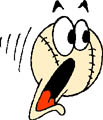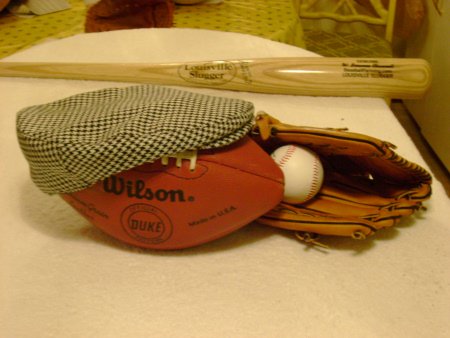Corkball
Corkball Is For All Ages, from 9 to 99
Corkball is simply another form of baseball that is more recreational and better suited for smaller playing areas.
A lot of kids growing up in St. Louis have been playing this game for many years. (as well as similar bat-and-ball games where there is no base running, such as bottle caps, fuzzball, and Indian ball).
St.Louis has grown this organized Cork-ball Clubs playing games within Leagues big time. The Deep South and in particularly the greater Metro Birmingham, Alabama area could have its own Clubs and League of play contact us:
Would you believe it this game was up and well at my dear ole Alma Mater API in the mid to late 1950's see my take on this game at Street Baseball. Now we can rekindle those thrilling days with modern era play with official rules and organized leagues.
In fact, this can be a great way for kids to learn to play baseball seeing as how the ball is much smaller than a baseball, the bat is thinner, therefore it takes more skill to hit a cork-ball.
A kid growing up learning to hit a cork-ball with a cork-ball bat will have little difficulty later when they begin playing baseball to put the bat to the ball.
A brief introduction/descriptive information on the other ball playing games is provided for you to experience many variations of playing ball.
Bottle caps is the same as cork-ball except you pitch and hit bottle caps.
Fuzzball is also the same, except you use a tennis ball. The fuzz on the tennis ball is often burned off with a cigarette lighter or blowtorch so that there is less wind resistance on the ball (it can be pitched faster). Fuzzball is also often played on paved school playgrounds and a strike zone may be painted on a wall behind the batter's box.
Stick-ball is the same (with some minor differences) except you use a Spalding Spaldeen (pink rubber) ball. In NYC they run the bases, too (and play it on the streets).
Indian ball is the same except you use a baseball.
Now before you know you are ready to really dig into how these other games are played you are in for a thrill.
The Metro Birmingham has the potential to have a Cork-ball League which could be up and pumping. All in the Metro Area Birmingham, Alabama lets play Cork-ball. Contact some buddies and lets crank her up "Whatta You Gonna Do" .
CORKBALL PLAYING RULES
by .... Markwort
The game rules and playing area diagram is taken from and provided courtesy of Markwort.
The Markwort ball is the official produced ball and bat:
You can buy these at several online sporting goods retailers, and also locally in St. Louis at Johnny Mac's Sporting Goods.
Foreword
The game has long been a favorite in the St. Louis area. It is a game that has many of the features of baseball yet can be played in a very small area.
It is a good summertime game because no exhausting action is required - the action is centered around the pitcher, the catcher and the batter; there is no base running.
Cork-ball is also played in winter in netted areas in gymnasiums. And there is no age limit - Corkball players range in age from six to 86.
Pitchers throw cork-ball fast balls, curves, knuckle-balls, sliders and change-ups. One swinging strike retires the batter, providing the catcher holds the pitch. Two strikes, either swinging or called, are out, providing the catcher holds the second strike.
Five balls constitutes a walk, the equivalent of a hit. Four walks, or four hits, or a combination of four walks and hits, scores a run, and each succeeding walk or hit in the same inning scores an additional run.
1.00 History
The game of cork-ball originated in St. Louis, Missouri, in the early 1900s. The game is played extensively in and around St. Louis and recently has spread to other parts of the country, as a result of St. Louis servicemen introducing the game to their buddies during World War II and the Korean conflict.
2.00 Playing Field
The playing field shall be laid out in accordance with the accompanying diagrams, located at the bottom of this page. Some organized leagues play in cages which are about seventy-five feet long and about twenty feet in width.
3.00 Equipment
3.01 The ball shall be an official cork-ball, weighing 1.25 ounces and measuring 6.25 inches in circumference.
3.02 The bat shall be no longer than thirty-eight inches long and, at its thickest part, may be no larger in diameter than 1.5 inches.
3.03 The catcher's glove is subject to the same limitations prescribed by official baseball rules for fielders gloves (gloves other than those used by the catcher and first baseman). A glove with a minimum of padding is recommended.
3.04 The catcher (as well as the umpire) shall be required to wear a mask to prevent possible injury (Markwort makes special masks for Cork-ball). All batters must wear a batting helmet.
3.05 Uniforms are optional. Players in organized leagues generally wear baseball or softball caps and softball-styled T-shirts. (Pitchers must wear a shirt other than white.)
3.06 Home plate and pitcher's plate are the same as those used in baseball.
4.00 The Game
4.01 Five innings of three outs each for both teams constitutes a game. Team scoring the most runs is the winner.
4.02 Each victory counts as two points in team standings. A tie game counts as one point for each team. (Note: Some teams dispense with tie games by playing extra innings. In such case, beginning with the sixth inning, each hit is scored as a run.)
4.03 A run is scored on four hits or four walks, or a combination of the two. After the first run is scored, each additional hit or walk in that inning scores another run.
4.04 A hit is any batted ball which settles in fair territory (i.e., beyond the foul line and the 15 foot circle), even though it may first hit the top or side of the cage. If it hits the back of the cage and bounces fair, it is a foul ball.
4.05 Five balls constitutes a walk. When batting averages are kept, a walk is not considered as a time at bat.
4.06 The batter is out when:
a) he hits a foul ball;
b) he hits a fair ball which is caught by one of the opposing players before first hitting the ground or touching the top or side of the cage;
c) he swings and misses a pitch, providing the catcher catches the ball before it hits the ground;
d) he takes two strikes, either or both of which may be called strikes, providing the catcher catches the second of the two;
e) he bunts the ball (bunting is illegal, batter must take a full swing);
f) if he is hit by a pitched ball while in the motion of swinging.
4.07 A batted ball which hits in fair territory and then rolls foul is a foul ball.
4.08 A pitched ball hitting either the batter or the bat without any motion on the part of the batter shall be adjudged a ball or strike by the umpire depending upon whether or not the ball was in the strike zone at the time of contact.
4.09 A pitched ball which hits the ground before reaching the plate may be swung at by the batter. If he hits a fair ball it is a hit, a foul ball is not. If he missed the pitch it is a strike. If he does not swing it is a ball, even though it may pass through the strike zone after hitting the ground.
4.10 If the catcher interferes with the batter's bat, causing him to strike out or foul out, the batter shall be awarded a walk. If a batter hits ball fair, it's a hit.
4.11 The batter must remain in the regulation batting box. If he steps out of the box or across the plate to swing at a pitch, he shall be declared out.
4.12 Pitcher must keep one foot on the pitcher's plate when delivering a pitch.
5.00 General
5.01 Five men constitute a team although the game may be played with a minimum of two men, a pitcher and a catcher, on each side.
5.02 There are no bases or base lines as there is no base running.
5.03 Although most organized leagues play in caged courts, the game is readily adaptable to open lots, parks, alleys, sidewalks, etc. One of the features of the game is that the playing space required is at a minimum.
5.04 When the game is not played in a cage, a home run line is optional. This line should be parallel to the foul line at a distance of 250 feet from home plate and should be well defined.
Additional lines can be marked 150 feet from home plate to be the single zone. Another line at 200 feet would be the double zone if the ball lands between the 150 and the 200 foot line. A triple would be a ball landing between the 200 foot line and a line at 250 feet.
If the hit lines are used, then the following additional scoring can be used;
The runners shall move the exact number of bases that the batter accomplishes as a hit. As per examples that follow:
Example Number 1 - There is a man on 2nd base, the batter hits a single, the runner on 2nd moves to third.
Example Number 2 - There is a man on 3rd base, the batter hits a single, the runner on 3rd scores.
Example Number 3 - There is a man on 3rd base, the batter walks, the runner on 3rd does not advance.
5.05 The foul line, fifteen feet in front of home plate, extends the width of the cage. When the game is not played in a cage, there are no limits to the ends of the foul line.
6.00 The Umpire
6.01 The umpire shall call balls and strikes and make any other decisions necessary to the playing of the game. All decisions based on the judgement of the umpire are final.
6.02 A decision wherein there is a difference of interpretation of a rule may be protested to league headquarters. Notification of the protest should be made to the umpire at the time of the disputed play. Such protests should be extremely rare, as decisions normally will be decisions of judgement and not of interpretation.
The official playing field measurements are provided by Markwort Playing Field Diagram
Jeff Kopp has created an online home for cork-ball players worldwide...This is a message board that includes articles, rules, information and discussions about not only cork-ball, but also fuzzball, stick-ball, Indian ball, bottle caps, and other bat-and-ballgames.
Click on the image to SHOP Baseball Books, Bats, Jewelry, Jerseys, and more...
Batter Up...Let's Play CorkBall...

